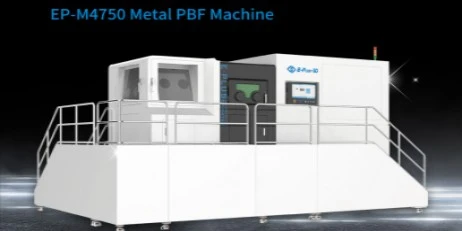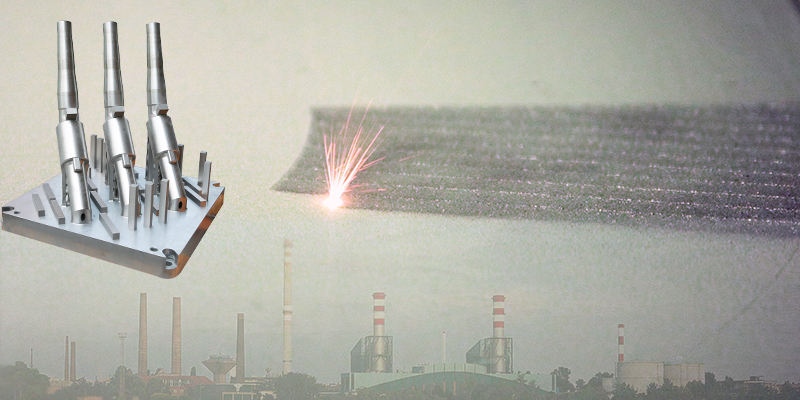The defects in MPBF process can be divided into the defects in powder recoating process and the defects in printing process. The defects in powder recoating process include irregular powder layer, and the defects in printing process include spatter, balling phenomenon, gas porosity, surface roughness, cracks, geometric deformation, etc. In the following, the cause of different defects is introduced, and the influence of different defects on the application of 3d printed parts are summarized.
Spatter
Spatter is one of the most common defects in the MPBF process, which directly affect the interaction between laser and powder bed, and lead to other defects. The results show that the spatter is mainly caused by the lateral inert gasflow, the fluctuation of the molten pool and the backflushing pressure. The spatter falling on the powder bed will redeposit larger metal particles, resulting in incomplete fusion and gas porosity defects, which is unfavorable for the tensile strength and fatigue properties of the parts. In addition, the spatter falling on the surface of the solidified layer will affect the powder recoating of next layer, resulting in uneven powder in the next layer, or even damage the recoater.

In order to prevent the metal powder bed from being contaminated by spatters, a high-speed inert gasflow can be used to remove the spatters. However, excessive gasflow will affect the surface quality of the powder layer. How to optimize the gasflow technology has become the direction of continuous efforts of 3d printer manufacturers.
Balling Phenomenon
Balling phenomenon is a unique metallurgical defect in the manufacturing process of metal powder bed fusion technology. This happens when the liquid metal solidifies into a sphere under the action of surface tension. This phenomenon can be caused by both high and low energy density of the laser beam. If the energy is too low, balling phenomenon will occur when the metal powder is not completely melted. If the energy is too high, it will occur when liquid metal splashes on the un-melted metal powder bed. Balling phenomenon will affect the powder quality of the next layer, affect the surface quality of parts, but also lead to lack of fusion, slag and other defects. Furthermore, balling can reduce the tensile strength and fatigue resistance of the 3d printed parts. The effective way to reduce and avoid balling phenomenon is to optimize the printing process and find the optimal parameter combination.

Gas Porosity
As one of the most important defects in the MPBF process, gas porosity is one of the most important defects affecting the mechanical properties of 3d printed parts. In the MPBF process, the rapid melting and solidification of the material and the violent fluctuation of the molten pool will lead to the gas porosity. The size, quantity, shape and position of gas porosity all have an important effect on the mechanical properties of the parts. The higher gas porosity will shorten the fatigue life of the build parts, and the influence of gas porosity near the surface on the fatigue properties of the build parts is greater than that of other positions. According to the formation mechanism of gas porosity, they can be divided into raw material related gas porosity and gas porosity caused by laser action.
The cause of gas porosity is very complicated and closely related to process parameters. Reasonable printing process and continuous process optimization are still important conditions to avoid the occurrence of gas porosity.
Surface Roughness
With the development of MPBF technology, the types of 3d printing materials are becoming more and more abundant, and the mechanical properties of components have been greatly improved. However, the relatively poor surface quality is still one of the major obstacles to the development and industrial application of MPBF. The surface roughness of the middle layer will affect the powder quality of the next layer, resulting in internal defects. The surface roughness of the build surface will seriously affect the fatigue performance of the parts.

SEM and reconstructed images of the upper surface under different laser power
The surface quality is closely related to the fluidity of molten pool. By adjusting the laser power, scanning speed, powder layer thickness and other process parameters, the surface quality can be effectively improved. Post-treatment can also be used to improve the surface quality of parts, but it will increase the cost and reduce the efficiency.
Cracks
Cracks in the MPBF process are related to temperature distribution, residual stress and incomplete fusion. Cracks caused by residual stress can be divided into solidification cracks and liquefaction cracks, which are related to materials. The solidification cracks are caused by the large temperature gradient between the molten pool and the solidified metal, which leads to the large deformation of the molten pool. However, the insufficient fluidity of the liquid cannot supplement the deformation caused by the molten pool. The liquefaction crack appears in the partial melting zone and is related to the liquefaction range, grain structure, thermal elongation, shrinkage of metal material.

Crack inside a metal 3d printed turbine blade
In addition, incomplete fusion can also causes cracks, which has a fatal impact on the mechanical behavior and fatigue life of 3d printed parts. Lack-of-fusion cracks usually occur between adjacent scanning channels or between sedimentary layers, which are mainly caused by incomplete melting of metal powder. If the cracks are serious, they may lead to delamination defects.

Layer delamination defect
Geometric Deformation
Due to the geometrical features, heat accumulation, stress concentration and other reasons of parts in MPBF process, geometric defects may be formed in different degrees. Small degree may lead to deformation and dimensional error, and serious degree may lead to incomplete structure, even failure of construction.




























